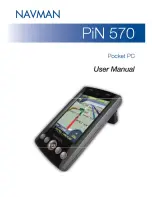
Application Deployment for Mobile 5.0
8 - 9
Storage
Windows Mobile 5.0 contains three types of file storage:
•
Random Access Memory (RAM)
•
Persistent Storage
•
Application folder.
Random Access Memory
Executing programs use RAM to store data. Data stored in RAM is lost upon a warm boot. RAM also included a
volatile file storage area called
Cache Disk
.
Volatile File Storage (Cache Disk)
Windows Mobile 5.0 memory architecture uses persistent storage for all files, registry settings, and database
objects to ensure data is retained even after a power failure. Persistent storage is implemented using Flash
memory technology which is generally slower than volatile RAM memory. In certain situations the speed of the
operation is more important than the integrity of the data. For these situations, Symbol has provided a small volatile
File Storage volume, accessed as the
Cache Disk
folder. Disk operations to the
Cache Disk
folder are much faster
than to any of the persistent storage volumes, but data is lost across warm boots and power interruptions. Note that
a backup battery powers RAM memory, including the
Cache Disk
, when you remove the main battery for a short
period of time.
The mobile computer uses the
Cache Disk
for temporary data that can be restored from other sources, for
example, for temporarily “caching” HTML web pages by a browser or generating formatted files to send to a printer.
Both situations benefit from the increased speed of the cache disk, but you can restore the data if needed.
DO NOT use the
Cache Disk
as a method to improve application performance. Analyze applications that perform
slower in persistent storage to optimize disk access. Common areas for optimization include minimizing the
number of reads and writes to a file, removing unneeded debug logging, and minimizing file flushing or closing
files.
Persistent Storage
Windows Mobile 5.0 protects all data and applications from power-related loss. Because Windows Mobile 5.0
mounts the entire file system and registry in persistent storage (rather than using RAM), MC909X devices provide
a reliable storage platform even in the absence of battery power.
Persistent storage provides application developers with a reliable storage system available through the standard
file system and registry APIs. Persistent storage is optimized for large reads and writes; therefore, applications
reading and writing data in large chunks tend to outperform those applications reading and writing small blocks of
data. Data in persistent storage is lost upon a clean boot.
Persistent storage contains all the directories under the root directory except for Application, Cache Disk, and
Storage Card (if a storage card is installed). Persistent storage is approximately 60 MB (formatted).
Application Folder
The Application folder is a super-persistent storage that is persistent even after a clean boot. Accessing data in the
Application folder is slower than accessing persistent storage. The Application folder is used for deployment and
device-unique data. For example, network profiles can be stored in the Application folder so that connection to the
network is available after a cold boot. The Application folder is approximately 20 MB (formatted).
Summary of Contents for MC909X
Page 1: ...MC909X Mobile Computer Integrator Guide ...
Page 2: ......
Page 3: ...MC909X Integrator Guide 72E 72216 06 Rev A December 2007 ...
Page 6: ...iv MC909X Mobile Computer Integrator Guide ...
Page 24: ...xxii MC909X Integrator Guide ...
Page 150: ...4 42 MC909X Integrator Guide ...
Page 220: ...8 14 MC909X Integrator Guide ...
Page 241: ...Staging and Provisioning 9 21 Figure 9 32 UnHide UI Selection ...
Page 252: ...9 32 MC909X Integrator Guide ...
Page 266: ...10 14 MC909X Integrator Guide ...
Page 300: ...B 24 MC909X Integrator Guide ...
Page 314: ...Glossary 14 MC909X Integrator Guide ...
Page 321: ......






































